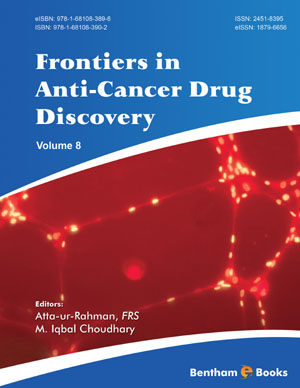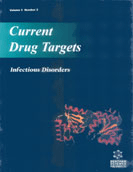Book Volume 8
Preface
Page: i-ii (2)
Author: Atta-ur Rahman and M. Iqbal Choudhary
DOI: 10.2174/9781681083896117080001
PDF Price: $15
List of Contributors
Page: iii-iv (2)
Author: Atta-ur Rahman and M. Iqbal Choudhary
DOI: 10.2174/9781681083896117080002
PDF Price: $15
T Cells in Gastrointestinal Cancers: Role and Therapeutic Strategies
Page: 1-28 (28)
Author: Carolina V. De Almeida, Ramon Kaneno and Amedeo Amedei
DOI: 10.2174/9781681083896117080003
PDF Price: $15
Abstract
Conventional treatments of gastrointestinal cancers based on surgical resection and chemotherapy are not enough to eradicate potentially relapsing tumor cells and can also impair the immune system functions. Immunotherapies aim to help the body to eradicate cancer and other diseases, by modulating the immune system. They can be performed by active approaches, usually orchestrated by dendritic cell vaccines that present a specific tumor associated antigen to T cells, or passive approaches, which have the T cells as protagonist, and are based on antitumor antibodies, or adoptive cell transfer. T lymphocyte subsets can exhibit different role face to a tumor scenario, varying from an effective cellular antitumor response to a regulatory participation. Although a lot of protocols to combat cancer progression have been proposed, T cell-based immunotherapies in gastrointestinal cancers are still not approved for clinical applications mainly because of their side effects. Nowadays, promising protocols combining two or more approaches, aiming to create an efficient therapy without or with fewer side effects. In this chapter, we made a review about the role of T cells on cancer, especially focusing on gastrointestinal cancer immunotherapeutic methods.
Adjudin - A Male Contraceptive with Anti-Cancer, Anti-Neuroinflammation and Anti-Ototoxicity Activities
Page: 29-45 (17)
Author: Yan-ho Cheng, Weiliang Xia, Xiang Xiao, Elizabeth Tang, Haiqi Chen, Qing Wen, Ying Gao, Dolores Mruk, Bruno Silvestrini and C. Yan Cheng
DOI: 10.2174/9781681083896117080004
PDF Price: $15
Abstract
Adjudin, 1-(2,4-dichlorobenzyl)-1H-indazole-3-carbohydrazide, is an indazole-based compound and a testis-specific adherens junction disruption inducer. Adjudin is also an analog of the anticancer drug lonidamine. Studies have shown that adjudin is an effective male contraceptive in rats, rabbits, and beagle dogs. Adjudin is known to exert its effects primarily at the testis-specific actin-rich adherens junction known as ectoplasmic specialization (ES), most notably in the adluminal compartment called apical ES at the Sertoli-spermatid (step 8-19) interface in adult rat testes. Similar ultrastructures of apical ES are also found in the mouse, dog and human testes. Specifically, adjudin has been shown to perturb the organization of actin microfilament bundles at the ES, which in turn, perturbs adhesion protein complexes that utilize F-actin for attachment. The net result thus perturbs spermatid adhesion to the Sertoli cell in the testis, leading to massive exfoliation of elongated/elongating spermatids, to be followed by round spermatids, spermatocytes and differentiated spermatogonia, but not undifferentiated spermatogonia. This thus induces reversible infertility in rats, rabbits and beagle dogs due to the loss of germ cells in the seminiferous epithelium; and undifferentiated spermatogonia gradually replace all classes of germ cells via spermatogenesis, making the adjudin treated animals fertile again. Recent studies, however, have shown that adjudin also possesses biological activities to disrupt cancer growth and tumorigenesis. It also interferes with neuroinflammation by reducing ischemia-induced microglial activation in mice. Furthermore, adjudin protects rodent cochlear hair cells against gentamicin-induced ototoxicity via the SIRT3-ROS (SIRT3 also known as Sirtuin 3, silent mating type information regulation 3 homolog (a mitochondria NAD-dependent protein deacetylase)-reactive oxygen species) pathway. In this review, we summarize some of the recent findings, in particular the likely mechanism(s) of action, regarding the multiple biological activities of adjudin, illustrating this potential male contraceptive has other added health benefits, such as preventing cancer growth and development. Furthermore, its use as novel anti-cancer drug is an area of research that can be further explored. Using a multidrug nanocarrier to deliver adjudin, in combination with other anti-cancer drug(s) (e.g. doxorubicin), this approach has been used successfully to eradicate drug resistant cancer cells.
Manipulating the Tumor Microenvironment: Opportunities for Therapeutic Targeting
Page: 46-71 (26)
Author: Peace Mabeta and Michael S. Pepper
DOI: 10.2174/9781681083896117080005
PDF Price: $15
Abstract
Over the years, there has been a marked change in the modalities of cancer treatment from the use of surgery and radiation therapy as gold standards to the employment of chemotherapy and combination approaches using a variety of modalities. Despite the advances, prognosis generally remains poor due to patients who develop toxicity or become refractory to therapy. The focus of treatment approaches has largely been on eliminating tumor cells. However, recent studies have shown that there is cross talk between tumor cells and their immediate environment, collectively known as the tumor microenvironment (TME). The TME contributes to certain characteristics of cancer such as hyperproliferation and angiogenesis. As such, the TME has been recognized as an important contributor to cancer progression, cellular invasion and metastatic dissemination. In addition, the TME has been reported to promote adaptive resistance to therapy in a number of cancers. Herein, we provide a brief overview of the pathophysiology of aspects of the tumor microenvironment. We further review emerging treatment modalities that target this niche and the mechanisms underpinning the efficacy of these therapies.
Current and Emerging Cancer Therapies for Treatment of Hepatocellular Carcinoma
Page: 72-103 (32)
Author: Sarwat Fatima, Nikki P. Lee and Zhao Xiang Bian
DOI: 10.2174/9781681083896117080006
PDF Price: $15
Abstract
Hepatocellular carcinoma (HCC) is one of the leading causes of cancer related deaths worldwide, especially in Asia. Late diagnosis and/or underlying cirrhosis, and limited treatment options with marginal clinical benefit are the reasons for its dismal prognosis. Surgical resection and liver transplantation are curative treatment options but are suitable for patients with small tumours or well-compensated liver diseases. For patients with non-resectable HCC, treatment options include ablative and systemic therapies. However, the results are unsatisfactory with limited long-term survival. In the last few years there has been active research in the area of molecularly targeted agents for HCC including anti-angiogenic therapy, immunotherapy, antiviral therapy, and other agents targeting mammalian target of rapamycin (mTOR), and c-met among others. This chapter will look into current treatment options, discuss their advantages and disadvantages, as well as introduce new therapies that are under clinical investigation but not yet recommended by acceptable guidelines. Although there is tremendous research in progress, the treatment modalities offer limited survival benefit and thus the battle against HCC is far from over.
Recent Development (from 2013 to 2015) of Gold- Based Compounds as Potential Anti-Cancer Drug Candidates
Page: 104-122 (19)
Author: Raymond Wai-Yin Sun, Chunxia Chen, Man-Kin Tse, Chih-Chiang Chen and Albert S.-C. Chan
DOI: 10.2174/9781681083896117080007
PDF Price: $15
Abstract
Cisplatin (Fig. 1) is a platinum(II) compound which contains two chlorido and two ammino ligands. In 1965 the biological activity of this compound was serendipitously discovered by Rosenberg et al. At present, this platinum(II) compound remains one of the effective chemotherapeutic agents for the treatment of various cancers in clinic [1]. The clinical success of this platinum compound has subsequently prompted the studies to identify other new metal-based therapeutic agents. As compared to organic molecules, metal-based compounds have unique physical, chemical and/ or biophysical properties. In this book chapter, we summarized the very recent progress (2013-2015) from the worldwide effort in the development of novel metal-based compounds. Some recent works on the anti-cancer studies of gold compounds including that of gold(I) and gold(III) will be discussed.
Oral Delivery by Nanostructures for the Treatment of Cancer
Page: 123-159 (37)
Author: Mahendar Porika, Rama Narsimha Reddy Anreddy, Radhika Tippani and Srividya Lonkala
DOI: 10.2174/9781681083896117080008
PDF Price: $15
Abstract
Oral administration of a drug is the most convenient route of treatment for the majority of diseases/disorders. However, there are limitations such as poor solubility, low intrinsic permeability, efflux transport, and extensive metabolism by the gastrointestinal (GI) tract/liver. To overcome these problems, nanoparticles (NPs) have been extensively studied as drug carriers. Previous results suggest that NP therapy can enhance the efficacy, while reducing side effects simultaneously. The development of nanotechnology for the management of cancer, a PEGgylated liposome NP formulation filled with anticancer drug (doxorubicin) had been developed as a first NP based therapy and received FDA approval in 1995. Approximately 20 varieties nanomedicine preparations are in for cancer chemotherapy clinical investigation. Various nano carriers used for cancer therapy need stabilization without effecting the physiological action of drug, its deposition at site of intended tumour and also decrease toxicity. The chapter emphases on NP technology with main focus on the formulation of nanomedicine for cancer therapy. This technique involves liposomes, polymeric NPs, polymeric conjugates, micelles, dendrimers, polymersomes and inorganic/metallic NPs.
Subject Index
Page: 160-168 (9)
Author: Atta-ur Rahman and M. Iqbal Choudhary
DOI: 10.2174/9781681083896117080009
PDF Price: $15
Introduction
Frontiers in Anti-Cancer Drug Discovery is a book series devoted to publishing the latest and the most important advances in anti-cancer drug design and discovery. Eminent scientists write contributions on all areas of rational drug design and drug discovery including medicinal chemistry, in-silico drug design, combinatorial chemistry, high-throughput screening, drug targets, recent important patents, and structure-activity relationships. The book series should prove to be of interest to all pharmaceutical scientists involved in research in anti-cancer drug design and discovery. Each volume is devoted to the major advances in anti-cancer drug design and discovery. The book series is essential reading to all scientists involved in drug design and discovery who wish to keep abreast of rapid and important developments in the field. The eighth volume of the series features chapters covering the following topics: - T cells in gastrointestinal cancers - The pharmacology of adjudin – a male contraceptive with anti-cancer properties - Manipulating the tumor microenvironment - Treatment of hepatocellular carcinoma - Gold-based compounds as potential anti-cancer drug candidates - Oral nanostructure drug delivery for anti-cancer treatment






















